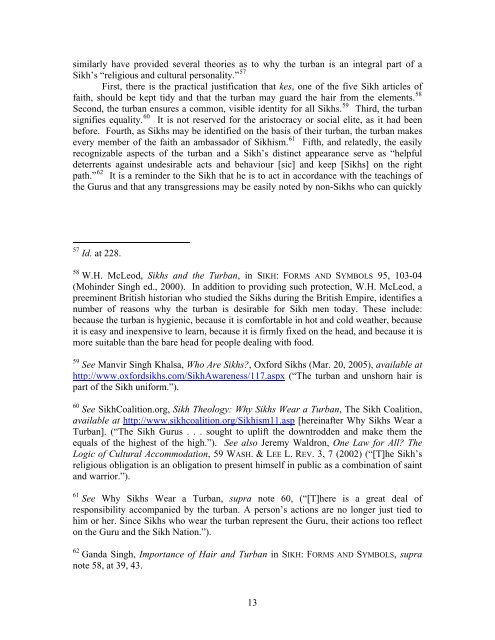The Sikh Turban: Post-911 Challenges to This Article of Faith
The Sikh Turban: Post-911 Challenges to This Article of Faith
The Sikh Turban: Post-911 Challenges to This Article of Faith
You also want an ePaper? Increase the reach of your titles
YUMPU automatically turns print PDFs into web optimized ePapers that Google loves.
similarly have provided several theories as <strong>to</strong> why the turban is an integral part <strong>of</strong> a<br />
<strong>Sikh</strong>’s “religious and cultural personality.” 57<br />
First, there is the practical justification that kes, one <strong>of</strong> the five <strong>Sikh</strong> articles <strong>of</strong><br />
faith, should be kept tidy and that the turban may guard the hair from the elements. 58<br />
Second, the turban ensures a common, visible identity for all <strong>Sikh</strong>s. 59 Third, the turban<br />
signifies equality. 60 It is not reserved for the aris<strong>to</strong>cracy or social elite, as it had been<br />
before. Fourth, as <strong>Sikh</strong>s may be identified on the basis <strong>of</strong> their turban, the turban makes<br />
every member <strong>of</strong> the faith an ambassador <strong>of</strong> <strong>Sikh</strong>ism. 61 Fifth, and relatedly, the easily<br />
recognizable aspects <strong>of</strong> the turban and a <strong>Sikh</strong>’s distinct appearance serve as “helpful<br />
deterrents against undesirable acts and behaviour [sic] and keep [<strong>Sikh</strong>s] on the right<br />
path.” 62 It is a reminder <strong>to</strong> the <strong>Sikh</strong> that he is <strong>to</strong> act in accordance with the teachings <strong>of</strong><br />
the Gurus and that any transgressions may be easily noted by non-<strong>Sikh</strong>s who can quickly<br />
57 Id. at 228.<br />
58 W.H. McLeod, <strong>Sikh</strong>s and the <strong>Turban</strong>, in SIKH: FORMS AND SYMBOLS 95, 103-04<br />
(Mohinder Singh ed., 2000). In addition <strong>to</strong> providing such protection, W.H. McLeod, a<br />
preeminent British his<strong>to</strong>rian who studied the <strong>Sikh</strong>s during the British Empire, identifies a<br />
number <strong>of</strong> reasons why the turban is desirable for <strong>Sikh</strong> men <strong>to</strong>day. <strong>The</strong>se include:<br />
because the turban is hygienic, because it is comfortable in hot and cold weather, because<br />
it is easy and inexpensive <strong>to</strong> learn, because it is firmly fixed on the head, and because it is<br />
more suitable than the bare head for people dealing with food.<br />
59 See Manvir Singh Khalsa, Who Are <strong>Sikh</strong>s?, Oxford <strong>Sikh</strong>s (Mar. 20, 2005), available at<br />
http://www.oxfordsikhs.com/<strong>Sikh</strong>Awareness/117.aspx (“<strong>The</strong> turban and unshorn hair is<br />
part <strong>of</strong> the <strong>Sikh</strong> uniform.”).<br />
60 See <strong>Sikh</strong>Coalition.org, <strong>Sikh</strong> <strong>The</strong>ology: Why <strong>Sikh</strong>s Wear a <strong>Turban</strong>, <strong>The</strong> <strong>Sikh</strong> Coalition,<br />
available at http://www.sikhcoalition.org/<strong>Sikh</strong>ism11.asp [hereinafter Why <strong>Sikh</strong>s Wear a<br />
<strong>Turban</strong>]. (“<strong>The</strong> <strong>Sikh</strong> Gurus . . . sought <strong>to</strong> uplift the downtrodden and make them the<br />
equals <strong>of</strong> the highest <strong>of</strong> the high.”). See also Jeremy Waldron, One Law for All? <strong>The</strong><br />
Logic <strong>of</strong> Cultural Accommodation, 59 WASH. & LEE L. REV. 3, 7 (2002) (“[T]he <strong>Sikh</strong>’s<br />
religious obligation is an obligation <strong>to</strong> present himself in public as a combination <strong>of</strong> saint<br />
and warrior.”).<br />
61 See Why <strong>Sikh</strong>s Wear a <strong>Turban</strong>, supra note 60, (“[T]here is a great deal <strong>of</strong><br />
responsibility accompanied by the turban. A person’s actions are no longer just tied <strong>to</strong><br />
him or her. Since <strong>Sikh</strong>s who wear the turban represent the Guru, their actions <strong>to</strong>o reflect<br />
on the Guru and the <strong>Sikh</strong> Nation.”).<br />
62 Ganda Singh, Importance <strong>of</strong> Hair and <strong>Turban</strong> in SIKH: FORMS AND SYMBOLS, supra<br />
note 58, at 39, 43.<br />
13
















